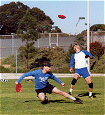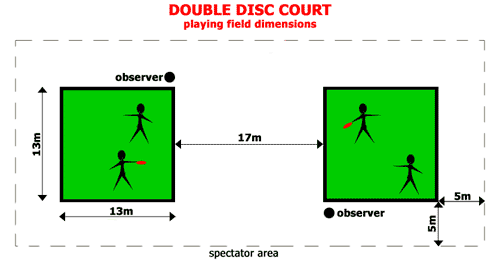![]()
 To tomannslag som forsvarer hver sin rute på 13m x 13m. Rutene er 17m fra hverandre. Ved serven er det en disk hos vært lag (på serv kaster begge lag på likt), og det gjelder å kaste disken inn i det andre lagets rute uten at det klarer å ta den. disken må lande og bli inne i ruta for at de som kaster skal få poeng. Hvis disken ruller ut av ruta, uten at spillerne har vært nær den, får mottakerne poeng. Et lag har bare lov å være nær en disk om gangen. Er to spillere fra samme lag nær diskene samtidig, får det andre laget 2 poeng. Kampene spilles vanligvis til 11, 15 eller 21 og man må vinne med 2 poeng. Man kan også spille flere sett som i tennis eller volleyball. Krever meget god kasteteknikk og en god porsjon taktikk. To tomannslag som forsvarer hver sin rute på 13m x 13m. Rutene er 17m fra hverandre. Ved serven er det en disk hos vært lag (på serv kaster begge lag på likt), og det gjelder å kaste disken inn i det andre lagets rute uten at det klarer å ta den. disken må lande og bli inne i ruta for at de som kaster skal få poeng. Hvis disken ruller ut av ruta, uten at spillerne har vært nær den, får mottakerne poeng. Et lag har bare lov å være nær en disk om gangen. Er to spillere fra samme lag nær diskene samtidig, får det andre laget 2 poeng. Kampene spilles vanligvis til 11, 15 eller 21 og man må vinne med 2 poeng. Man kan også spille flere sett som i tennis eller volleyball. Krever meget god kasteteknikk og en god porsjon taktikk. |
Offisielle DDC regler |
 doubledisccourt.com |
|
Front Counting System Making it Fun - Leverage Peoples' Existing Skills! Throwing out and shagging discs is no fun. Remember that you can play DDC with any two matching discs. Start ultimate players playing DDC with an ultimate disc. This allows them to use their throwing skills and to enjoy playing much more quickly than when using the 110G pro discs! (Alternatively two superpros make a nice bridge between the games, and they are softer and float more). Disc golfers used to throwing stable heavy plastic also benefit from a more stable (small) disc such as a 119G Disc. Once they start throwing hard enough to make catching an issue, you can move them to the light plastic. The 119G disc with courts only 15 meters apart was the official rule for years, and that worked great, so don't be a 110G snob. If they are not playing in a tournament who cares what disc they get started with as long as they are playing! Making it Fun - How Do I Escape?!? FCS also has a path for improvement by adding features to handle increasingly challenging escape situations. The FCS improvement path merges into the Back Calling escape system used widely today so there is no backtracking or things to unlearn. It is described below also. Please share it with your friends! Front Counting System Here is how FCS works: Copyright 1981, 2003 John Greensage. Permission to circulate freely and publish unmodified with this copyright notice intact. FAQs - Front Counting System Copyright 2003 John Greensage. Permission to circulate freely and publish unmodified with this copyright notice intact. Advanced Front Counting System Once the basic Front Counting System is mastered, you can make small enhancements to continue to get better at handling doubling attacks. These improvements readily add together. 1) Off Calls. The players (especially the front) says "off" once they have thrown the disc. The back player when milking a doubling shot, or milking after their tip does not catch until after the front player says "off". This eliminates many doubles, intentionally sacrificing only one point instead. 2) Short Counts. Short counts are for dealing with fast doubling shots (i.e. burns). The front reduces the count when the attack is from the opposing front line, barking "1---catch". The counting time needs to be consistent. The key is a count giving enough time for the back to execute a tip if the back's disc is within tipping range. 3) Barking. Front counts are made with short sharp barks. This is key to being able to hear back calls in more advanced play. 4) Back Calls. The back makes a call of "me" or "you" for which player will play their disc first. The back calls this as soon as the back decides to tip the lead shot or to milk it to the ground. If the front hears a "me" call, then the front makes a normal throw (i.e. the front assumes some reasonable time from the back's tip). If the back calls "you", then the front player makes a quick throw as before. 5) Time Calls. The back adds a third call of "time" to the options of "me" and "you" calls. The back calls "time" when the back decides to milk *and* their disc is very slow (i.e. it will be a lengthy time from when the front is going to say "catch" to when the back's disc will land. 6) Waiting for the Back Tip. When the front hears a "me" call, the front waits for the tip sound, only catching their disc once it is heard, and makes a normal throw (i.e. the front assumes some reasonable time from the back's tip). If the tip is not heard then the front must let their disc drop untouched. The back may also say "tip" at the moment of the tip in order to provide a more readily heard sound for the front. 7) Front Tipping. When the front player gets a "you" call, they may tip their disc or quick throw at their option. If they tip, they call "tip" as they do, and milk their tip to the ground. The back upon hearing the front "tip" call catches and throws their disc. As they release they bark "off". The front player hearing "off" is allowed to catch their tip. If the front's tip is low or uncatchable, the front should call "hold" and allow their tip to drop to the ground untouched. 8) Back Counting. The back counts the lead shot *before* the doubling shot is thrown. (Starting at 5, saying "5-4-3-2---"). The front hearing this count decides what to do with their front milk window (i.e. tip or milk the doubling shot) and begins counting based on that choice. The back stops counting as soon as the front starts (and always stops on two) so as to have clear and clean communication between each other. Copyright 2003 John Greensage. Permission to circulate freely and publish unmodified with this copyright notice intact. Handy Beginning DDC Guide Throw into the back of the court. When the opponent is deeper in their court, it is harder for them to attack you. Always shout "HOLD" anytime your disc is going out, or is going to hit the ground, or you can not play it. The other player then holds. It does not really matter if it is in or out, the other player needs to do the same thing, so make the call simple. Try to catch the disc on the rim in a grip, and on the side of your body, such that you can throw it more quickly. For example, upside down throws can be caught such that you can turn them over and throw them back right side up without changing your grip. It takes some work, but you will find that this is far faster than changing your grip! Copyright 2003 John Greensage. Permission to circulate freely and publish unmodified with this copyright notice intact. |
| DHTML JavaScript Menu Courtesy of Milonic.com |